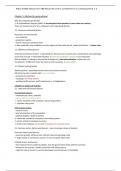Zusammenfassung
Internationele BWL-Zusammenfassung - Vertical, Horizontal and Lateral Integration and Cooperation - Mergen & Acquisition, Joint Venture, Franchise - Motives for going abroad - Multi national Companies (MNCs)
- Hochschule
- Gymnasium
Internationale BWL: Themenbereich: - Horizontale, vertikale und alterale kooperation und Integration - Merger and Acquisitions (M&A) - Joint Venture - Franchise - Multi National Companies
[ Mehr anzeigen ]




